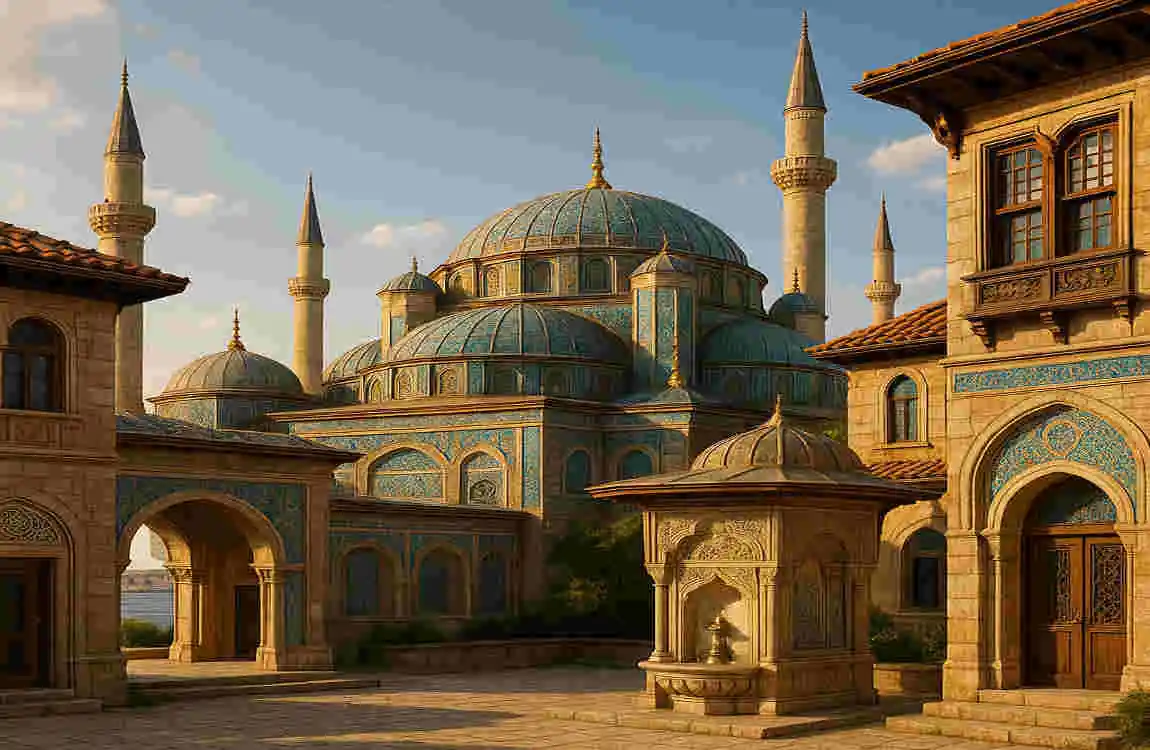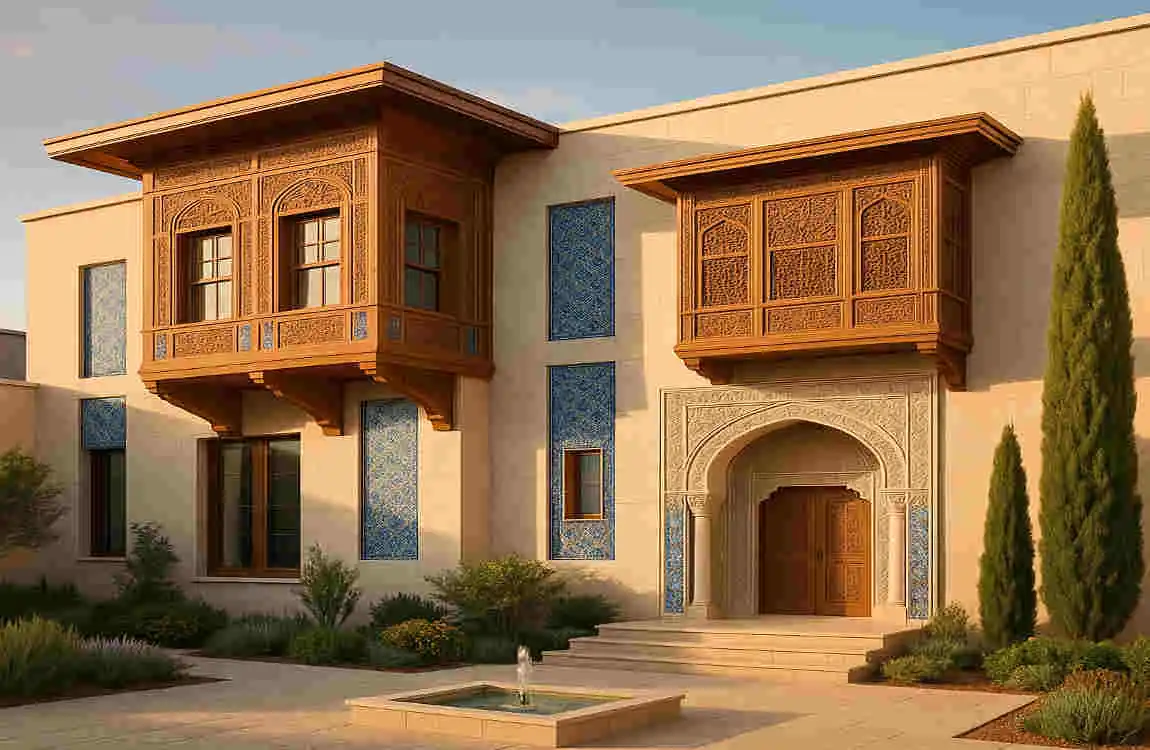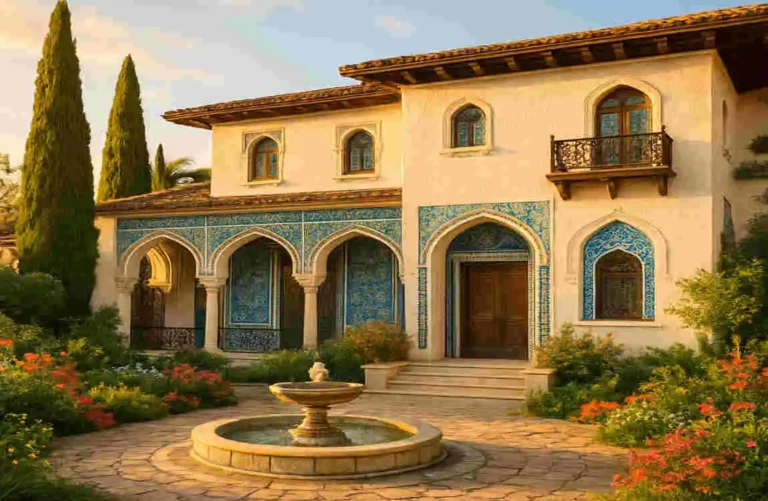Hey there, have you ever dreamed of transforming the outside of your home into something truly captivating? Something that not only turns heads but also tells a story of culture and history? If so, let’s dive into the mesmerising world of Turkish house design outside. This unique style, rooted in centuries of tradition, is making waves globally for its charm and elegance.
Turkish exterior architecture isn’t just about looks—it’s about creating a space that feels like home while boosting your property’s value and appeal. From ornate balconies to earthy colour tones, there’s so much to explore. In this article, we’ll explore the magic of Turkish house design, walking you through its history, key features, modern twists, and even how to bring a slice of Turkey to your backyard. Ready to elevate your home? Let’s get started!
Historical and Cultural of Turkish Exterior Design

The Roots of Turkish Architecture
Let’s take a step back in time. Turkish house design, particularly its exterior, is deeply rooted in the country’s rich history. Spanning from the grandeur of the Ottoman Empire to the rustic charm of Anatolian villages, these homes reflect a blend of influences that have evolved over centuries. The exteriors aren’t just walls and roofs—they’re a canvas showcasing Turkey’s diverse cultural tapestry, including touches from Balkan and Middle Eastern traditions.
Cultural Influences Shaping Exteriors
Think of Ottoman palaces with their intricate details or the simple, functional homes of rural Anatolia. These designs didn’t happen by accident. They were shaped by the people, their lifestyles, and their surroundings. For instance, the Ottoman influence brought ornate wooden carvings and grand balconies, while Balkan touches added a cosy, communal feel to outdoor spaces. Every element tells a story of who lived there and how they connected with their environment.
The Iconic “Sofa” Concept
One standout feature in traditional Turkish house design outside is the “sofa”—not the couch, but an open exterior veranda or porch, often referred to as the “exterior sofa” or part of the “Hayat house” concept. This space was the heart of the home’s outdoor life, a place for family gatherings, sipping tea, or just enjoying the breeze. It’s more than a design choice; it’s a reflection of Turkish hospitality and community spirit.
Adapting to Lifestyle and Climate
Turkey’s varied climate—scorching summers in the south and chilly winters in the east—also played a significant role in shaping its exteriors. Homes were built to stay cool with shaded verandas and thick walls, or to retain warmth with snug layouts. The exterior wasn’t just for show; it was a practical response to the natural environment. Isn’t it fascinating how design can be both beautiful and functional? How does your home adapt to your local weather? Let’s think about that as we explore more.
Key Characteristics of Turkish House Design Outside
Natural Materials That Speak of Tradition
When you look at a traditional Turkish home, the first thing you might notice is the use of natural materials. Think sturdy stone walls, warm wooden beams, and smooth plaster finishes. These aren’t just random picks—they connect the home to the earth, blending it into the landscape. Stone keeps things cool in the heat, while wood adds a touch of rustic charm. It’s like the house is hugging nature itself.
You may also read (do you really have to pay for extreme home makeover).
Unique Roof Styles
Let’s talk roofs. Turkish homes often feature pitched, tiled roofs that aren’t only practical for rain but also visually appealing. The tiles, often in earthy reds or browns, create a striking contrast against the sky. These roofs aren’t flat for a reason—they handle Turkey’s rainy seasons with ease while adding a classic silhouette to the home. Can you picture one of these on your house?
Ornate Balconies and Verandas
Here’s where the magic happens: the balconies and verandas, often tied to the “exterior sofa” concept we mentioned earlier. These spaces, supported by arches or carved wooden columns, are the soul of Turkish exterior architecture. They’re not just pretty; they’re a place to live life, whether it’s chatting with neighbours or enjoying a quiet evening. The intricate details, like latticework or curved edges, make them stand out as true works of art.
Colour Palettes That Pop
Turkish exteriors often feature earthy tones—think beige, terracotta, or soft grey. But here’s the fun part: they’re paired with bright accents like turquoise or deep red in window frames or doors. Traditional motifs, sometimes painted or carved, add a splash of personality. It’s a balance of subtle and bold that makes the home feel alive. What colours do you think would bring your exterior to life?
Blurring Indoor and Outdoor Spaces
One thing I love about Turkish design is how it connects the inside with the outside. Those open verandas or “sofas” aren’t just add-ons; they’re extensions of the living space. They make the home feel bigger, airier, and more inviting. It’s perfect for social gatherings or just soaking in the outdoors without stepping too far from comfort. Imagine hosting a barbecue in such a space—wouldn’t that be amazing?
Gardens and Courtyards as Complements
No Turkish exterior is complete without a touch of green. Gardens and courtyards, often framed by low stone walls or fences, are integral to the design. They’re not just for looks—they provide shade, privacy, and a spot to relax. Native plants and simple layouts keep it low-maintenance yet stunning. How does your outdoor space stack up? Could a courtyard add that extra charm?
Functional Design for All Seasons
Lastly, let’s not forget functionality. Turkish exteriors are built for the real world. Shading from overhanging roofs or verandas keeps summer heat at bay, while thick walls trap warmth in winter. Ventilation is key too—open designs let breezes flow through. It’s a reminder that good design isn’t just pretty; it solves problems. What challenges does your home face with the weather?
Modern Interpretations and Innovations in Turkish Exterior Design
Blending Old with New
Fast forward to today, and Turkish exterior design is no longer stuck in the past. Modern architects are incorporating traditional elements—such as wooden balconies or stone walls—and blending them with sleek, minimalist styles. The result? Homes that feel timeless yet fresh. It’s like wearing a vintage jacket with modern sneakers—classic, but with a twist.
Dual-Facade Homes for Smart Living
One cool trend is the dual-facade approach. Some Turkish homes now feature contrasting sides—one might be made of timber for warmth, while the other is made of stone for durability. This isn’t just for looks; it optimises light, heat, and views based on the home’s orientation. Imagine a house that adapts to the sun and wind—pretty smart, right? It shows how Turkish house design outside can be both practical and stunning.
Sustainable Touches
Sustainability is also making its way into Turkish exteriors. Consider solar panels discreetly integrated into tiled roofs or systems designed to collect rainwater. These modern upgrades don’t clash with tradition—they enhance it. They keep the cultural essence alive while meeting today’s environmental needs. How could your home become a bit greener with such ideas?
Preserving Cultural Essence
Even with these innovations, the heart of Turkish design remains. Architects ensure that new materials or tech don’t overshadow the cultural roots. Whether it’s a minimalist veranda or a modern courtyard, there’s always a nod to history. It’s a beautiful balance—don’t you think we could all learn from that in our own spaces?
How to Incorporate Turkish House Design Elements Outside Your Home

Start with Materials and Colours
You may also read (how to sell a house with polybutylene pipes).
Ready to bring a touch of Turkey to your home? Let’s start with the basics: materials and colours. Go for natural picks like stone or wood for walls or accents. Stick to earthy tones—think sandy beige or warm terracotta—but don’t shy away from a pop of colour like a blue door or red trim. It’s an easy way to mimic Turkish exterior architecture without a complete overhaul.
Design Your Exterior Sofa or Veranda
Now, let’s talk about the star of the show: the exterior sofa or veranda. This open, covered space is perfect for relaxing or entertaining. Use wooden posts or arches for support, and keep it airy but shaded. Add a few cushions or a small table, and you’ve got a cosy spot. Doesn’t that sound like the perfect addition to your backyard?
Add Ornamental Details
Turkish exteriors love a bit of flair. Try adding patterned ceramic tiles around windows or doors for a stylish touch. Wrought iron railings or latticework on balconies can also bring that traditional vibe. These little touches make a big difference—they’re like jewellery for your home. What small detail could you add to make your exterior stand out?
Landscaping to Match
Don’t forget the outdoors! Create a small courtyard or garden with native plants or low-maintenance greenery. Use stone paths or gravel to maintain authenticity. A simple fountain or bench can tie it all together, making your exterior feel like a Turkish retreat. How can you turn your yard into a welcoming oasis?
Balance Tradition with Functionality
Here’s a tip: don’t overdo the ornamentation. Turkish design is ornate but practical. Ensure your veranda or balcony is both usable and visually appealing. Consider weatherproofing or installing modern lighting for evening use. It’s all about blending old-world charm with today’s needs. How can you create a space that is both stylish and functional?
Maintenance for Longevity
Traditional materials, such as wood or plaster, require some care. Seal wooden elements to protect against rain, and check stone or plaster for cracks. A little upkeep goes a long way in keeping your Turkish house design outside looking fresh. Additionally, platforms like Pinterest offer a wealth of visual inspiration for Turkish exteriors—why not take a look for ideas?
- Quick Material Tips: Use weather-resistant sealants for wood; opt for durable stone types.
- Colour Refresh: Repaint accents every few years to maintain vibrancy.
Benefits of Adopting Turkish Exterior House Design
Standout Curb Appeal
Let’s be honest—first impressions matter. A home with a Turkish-style exterior design instantly grabs attention. Those unique balconies, earthy tones, and intricate details make your property a standout in the neighbourhood. It’s not just a house; it’s a statement. Wouldn’t you love your home to be the one everyone talks about?
Better Outdoor Living
Turkish exteriors, with their verandas and courtyards, make outdoor living a joy. These spaces are ideal for family gatherings, parties, or simply unwinding after a long day. They invite connection and relaxation. Imagine sipping coffee on your exterior sofa—doesn’t that sound like the good life?
Climate-Friendly Design
As we’ve seen, Turkish design is built for all seasons. Shaded areas keep you cool in summer, while sturdy materials handle winter chills. It’s a practical choice if you live in an area with changing weather conditions. How could your home benefit from such clever design?
Cultural Connection and Value Boost
Adopting this style also connects you to a rich heritage. It’s a nod to timeless principles of beauty and function. Plus, a unique exterior can bump up your property’s value—who doesn’t love a home with character? It’s an investment in both style and substance.
Case Studies / Examples of Turkish House Design Outside
Traditional Gems in Kula
Let’s look at some real examples. In Kula, a historic town in Turkey, traditional homes with open exterior sofas shine. These houses feature wooden verandas with intricate carvings, blending seamlessly with the surrounding stone walls. They’re built for community—perfect for gatherings—and their thick walls keep interiors comfy year-round. Isn’t it inspiring how design can serve both beauty and purpose?
Modern Marvel: The Two-Face House
On the modern side, check out the “Two Face House” in Turkey, a project highlighted by Dezeen. This home features dual facades—one made of timber, the other of stone—to accommodate climate change. One side maximises sunlight, while the other offers shade. It’s a brilliant take on Turkish exterior architecture, showing how tradition meets innovation. Could a dual design work for your space?
Timeless and Practical
Both examples—traditional and modern—illustrate how Turkish exteriors strike a balance between aesthetics and practical needs. From ventilation in Kula homes to bright facades in modern builds, these designs adapt to life. They’re not just pretty pictures; they’re lived-in spaces. What can you take from these to enhance your own home?
You may also read (does home interiors still exist in todays design world).
